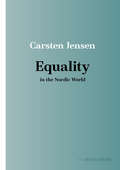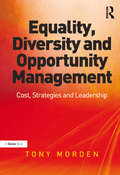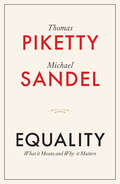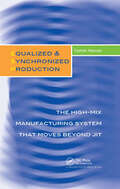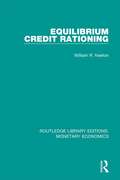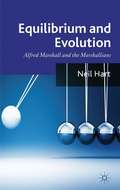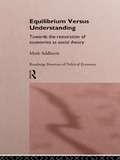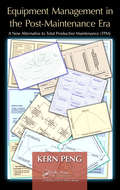- Table View
- List View
Equality for Women = Prosperity for All: The Disastrous Global Crisis of Gender Inequality
by Augusto Lopez-Claros Bahiyyih NakhjavaniA groundbreaking book about the direct relationship between a woman's rights and freedoms and the economic prosperity of her country. "The authors speak to hearts as well as minds." —Maud de Boer Buquicchio, UN Special Rapporteur“Not only timely but profoundly important—a must-read." Jackie Jones, Professor of Feminist Legal studiesGender discrimination is often seen from a human rights perspective; it is a violation of women’s basic human rights, as embedded in the Universal Declaration, the UN Charter and other such founding documents. Moreover, there is overwhelming evidence that restrictions and various forms of discrimination against women are also bad economics. They undermine the talent pool available to the private sector, they distort power relationships within the family and lead to inefficiencies in the use of resources. They contribute to create an environment in which women, de facto, are second class citizens, with fewer options than men, lower quality jobs, lower pay, often the victims of various forms of violence, literally from the cradle to the grave. They are also not fully politically empowered and have scant presence in the corridors of power, whether as finance ministers, central bank governors, prime ministers or on the boards of leading corporations. Why is gender inequality so pervasive? Where does it come from? Does it have cultural and religious roots? And what are the sorts of policies and values that will deliver a world in which being born a boy or a girl is no longer a measure of the likelihood of developing one’s human potential?
Equality for Women: Where Do We Stand?
by Andrew R. Morrison Mirja Sjöblom A. Waafas Ofosu-Amaah Mayra BuvinicUpon signing the Millennium Declaration in 2000, the international community committed itself to eight development goals with timebound targets and measurable indicators. The third of these eight goals was to 'promote gender equality and empower women'. The third Millennium Development Goal (MDG3) in the Millennium Declaration has spurred national and international efforts to improve women's situation around the globe. 'Equality for Women: Where Do We Stand on Millennium Goal 3?' tracks countries' progress with implementing and financing MDG3 by examining national experiences and successes with policies and programs. It also contains an assessment of the effectiveness of different strategies in achieving MDG3 and the financial requirements needed to attain MDG3 by 2015. 'Equality for Women' will be useful for gender analysts, policy makers, government officials, and others working to promote gender mainstreaming.
Equality in Water and Sanitation Services (Earthscan Water Text)
by Oliver Cumming Tom SlaymakerThere is growing acceptance that the progress delivered under the Millennium Development Goal target for drinking water and sanitation has been inequitable. As a result, the progressive reduction of inequalities is now an explicit focus of the Sustainable Development Goal (SDG) targets, adopted in 2015, for universal access to drinking water, sanitation and hygiene (WASH). This shift in focus has implications for the way in which the next generation of WASH policies and programmes will be conceived, designed, financed and monitored. This book provides an authoritative textbook for students, as well as a point of reference for policy-makers and practitioners interested in reducing inequalities in access to WASH services. Four key areas are addressed: background to the human right to water and development goals; dimensions of inequality; case studies in delivering water and sanitation equitably; and monitoring progress in reducing inequality.
Equality in the Nordic World (Nordic World)
by Carsten JensenBy most measures, the Nordic countries regularly rank among the best in terms of equality and business friendliness. Political scientist Carsten Jensen delves into what is exceptional about equality in the region, and outlines “the four equalities” that set it apart: economic, intergenerational, gender, and health. The four types of equality have their origins in unique political compromises made in the twentieth century. The resulting social market economies of these countries affect their growth and levels of equality even today.
Equality of Opportunity and Outcome in the U.S.
by Matthew C. Weinzierl Alastair SuEquality of opportunity is endorsed universally even though, or more likely because, it can mean such different things to different people. What definition of equality of opportunity ought to figure into policy decisions? How close, or far, is the United States from providing equal opportunity? Instructors may also obtain a Teaching Note, written by this case's author, that provides suggestions for using this case effectively in the classroom.
Equality of Opportunity and the Importance of Place: SUMMARY OF A WORKSHOP
by Joah G. Iannotta Jane L. RossA summary on Equality of Opportunity and the Importance of Place
Equality, Diversity and Inclusion in the Workplace: International Contexts, Policies and Practices
by Ciarán McFaddenGain a contemporary and complete understanding of the concepts, theories and practical considerations integral to modern diversity management with this textbook.Equality, Diversity and Inclusion in the Workplace provides a clear and accessible introduction to the subject, finely balancing theoretical and practical considerations to enable students to engage with EDI issues with confidence and understanding. It discusses concepts and theories relevant to EDI from a range of disciplines, outlining the major legislation impacting on EDI organizational practice worldwide.This textbook also features an in-depth exploration of the key issues, challenges and considerations regarding respective employee groups and analyses concepts such as intersectionality, diversity resistance, allyship and issues of 'rhetoric versus reality'. It features insights from EDI experts across the globe as well as legal cases and examples from the likes of General Motors and Tata Consultancy Services. It is supported by a range of learning features including learning outcomes, 'often misunderstood' features, practical activities and debate questions.With a suite of online resources including lecture slides, teaching resources and further long-form case studies, this is an essential resource for postgraduate and upper undergraduate HRM and business students studying modules relating to equality, diversity and inclusion.
Equality, Diversity and Opportunity Management: Costs, Strategies and Leadership
by Tony MordenEquality, Diversity and Opportunity Management presents a comprehensive analysis of the processes of governance, leadership, policy and strategy formulation, decision-making, practical and financial management, and real-world implementation of the Equality, Diversity, Opportunity, and Discrimination (or anti-Discrimination) Agenda. The leadership, cost, and management of the Agenda for Equality, Diversity, Opportunity, and Discrimination (or anti-Discrimination) is discussed in three mandatory areas: ¢ Employment and the Workplace ¢ Service Provision and customer service ¢ Neighbourhood and Community Management The necessary choice of these three key areas of application reflects a typical focus of government policy, legislation, and case law for the UK, Europe, North America, Australia, New Zealand, and in many other countries that implement active Human Rights Agendas. You will find the book strongly orientated towards issues of corporate governance, personal and vicarious responsibility, leadership, cost management, implementation, and delivery. It deals directly, professionally, and in a non-opinionated manner with challenging (and sometimes unpopular or unwanted) issues of equality and inequality, diversity, a lack of opportunity or social mobility, and the widespread incidence of discrimination. The work suggests practical and realistic means to deal with such issues, whether at the level of corporate governance, leadership, policy and strategy, the incurring of unnecessary cost, or at the level of operational and departmental management procedure and process. Equality, Diversity and Opportunity Management is written at the same time from scholarly, objective, applied, proportionate, ’hands-on’, and practitioner based perspectives.
Equality: What It Means and Why It Matters
by Michael J. Sandel Thomas PikettyIn this compelling dialogue, two of the world’s most influential thinkers reflect on the value of equality and debate what citizens and governments should do to narrow the gaps that separate us. Ranging across economics, philosophy, history, and current affairs, Thomas Piketty and Michael Sandel consider how far we have come in achieving greater equality. At the same time, they confront head-on the extreme divides that remain in wealth, income, power, and status nationally and globally. What can be done at a time of deep political instability and environmental crisis? Piketty and Sandel agree on much: more inclusive investment in health and education, higher progressive taxation, curbing the political power of the rich and the overreach of markets. But how far and how fast can we push? Should we prioritize material or social change? What are the prospects for any change at all with nationalist forces resurgent? How should the left relate to values like patriotism and local solidarity where they collide with the challenges of mass migration and global climate change? To see Piketty and Sandel grapple with these and other problems is to glimpse new possibilities for change and justice but also the stubborn truth that progress towards greater equality never comes quickly or without deep social conflict and political struggle.
Equalized & Synchronized Production: The High-Mix Manufacturing System that Moves Beyond JIT
by Toshiki NaruseBeyond JIT - Lean Improvement for Supplier Companies!ESP is a production management and manufacturing improvement system targeted for supplier companies or any companies that deal with a variety of products as well as multiple customers. ESP enables suppliers to meet the requirements of their buyers' Just-In-Time (JIT) ordering systems through wide-variety, small-lot production, while also making their own production activities as efficient as possible.ESP complements each company's own production management functions, particularly the production scheduling and purchasing functions, in the way that best suits each individual business. By adopting ESP, your company will be able to meet its customers' needs Just-in-Time while growing into a powerful new organization operating according to its own production system.Features of Equalized and Synchronized Production include: Coverage of the complete production scheduling and management system for supplier organizations Case studies featuring ESP implementation by a variety of manufacturers Guidance on when and where the ESP system is more effective than JIT Comprehensive and practical "how-to" instruction on ESP implementation
Equalizing the Three Pillars of Sustainability: Exploring Social Responsibility in Context (Approaches to Global Sustainability, Markets, and Governance)
by David Crowther Shahla SeifiThis book explores the multifaceted concept of sustainability, a term that has become central to global discussions among academics, policymakers, business leaders, and communities. Recognizing sustainability as a critical challenge for the future of our planet and its inhabitants, the book examines its three interconnected pillars: economic, environmental, and social. Among these, the social dimension is highlighted as having potentially the most profound impact on how we live and shape our collective future. Through a series of case studies and analyses, the book investigates actions taken across the globe to address sustainability, emphasizing the diversity of contexts, challenges, and outcomes. It goes beyond simply cataloging efforts, offering a deeper exploration of the conditions under which these initiatives were developed and implemented. The contributors, representing diverse international perspectives, provide valuable insights into local adaptations and global best practices, fostering a rich exchange of ideas and strategies. This book not only captures the current state of sustainability efforts but also reflects on emerging trends and the need for innovative approaches to navigate an ever-changing landscape. By bringing together global expertise, it aims to enrich the sustainability discourse and inspire meaningful progress. It is an essential read for those seeking a nuanced understanding of sustainability and its practical implications across economic systems, environmental stewardship, and societal transformation.
Equator Principles: An Industry Approach to Managing Environmental and Social Risks
by Carin-Isabel Knoop Aldo Sesia Benjamin C. EstyIn June 2003, 10 leading international banks adopted new voluntary guidelines, called the Equator Principles, to promote sustainable development in project finance. In recent years, nongovernmental organizations (NGOs) had raised issues about the lenders' responsibilities in projects that could harm the environment and/or society. Although many banks had environmental policies in place, a uniform industry standard did not exist. The principles, borrowed from and with the active support of the World Bank's International Finance Corp. (IFC), established guidelines to ensure that banks financed only projects that were "socially responsible and reflected sound environmental management practices." Some NGOs applauded the banks' efforts, others criticized the principles for reasons related to their scope, implementation procedures, and enforcement mechanisms. The Equator banks had to decide what to do next. They could try to recruit more banks (and export credit agencies), develop implementation procedures, or respond to the criticism directly.
Equatorial Guinea: Selected Issues and Statistical Appendix
by International Monetary FundA report from the International Monetary Fund.
Equilibrium Credit Rationing (Routledge Library Editions: Monetary Economics #4)
by William R. KeetonThis study, first published in 1979, examines and contrasts two concepts of credit rationing. The first concept takes the relevant price of credit to be the explicit interest rate on the loan and defines the demand for credit as the amount an individual borrower would like to receive at that rate. Under the alternative definition, the price of credit consists of the complete set of loan terms confronting a class of borrowers with given characteristics, while the demand for credit equals the total number of loan which members of the class would like to receive at those terms. This title will be of interest to students of monetary economics.
Equilibrium Models in an Applied Framework
by Ronny NorénThis book gives the historical development, explanations of technical specifications, and a basic understanding of how to use different equilibrium models in an applied framework. It contains an accessible analytical survey of economic equilibrium models, including multi-sector programming models (linear and quadratic) and the computable general equilibrium (CGE) model. The book introduces the importance of disinvestment, and hence, a model of economic transformation is developed. Finally, the globalisation process of the production system is examined. The equilibrium models in this book are presented in an easy way. Although the book is primarily written for advanced undergraduates and beginning graduates, the reading of the book will appeal to anyone interested in economic theory and applied modelling in the field of economics.
Equilibrium Non-Oil Current Account Assessments for Oil Producing Countries
by Jun Il Kim Alu Thomas Aqib AslamA report from the International Monetary Fund.
Equilibrium Unemployment Theory (2nd edition)
by Christopher A. PissaridesAn equilibrium theory of unemployment assumes that firms and workers maximize their payoffs under rational expectations and that wages are determined to exploit the private gains from trade. This book focuses on the modeling of the transitions in and out of unemployment, given the stochastic processes that break up jobs and lead to the formation of new jobs, and on the implications of this approach for macroeconomic equilibrium and for the efficiency of the labor market. This approach to labor market equilibrium and unemployment has been successful in explaining the determinants of the "natural" rate of unemployment and new data on job and worker flows, in modeling the labor market in equilibrium business cycle and growth models, and in analyzing welfare policy. The second edition contains two new chapters, one on endogenous job destruction and one on search on the job and job-to-job quitting. The rest of the book has been extensively rewritten and, in several cases, simplified.
Equilibrium and Economic Theory (Routledge Studies in the History of Economics)
by Giovanni Alfredo CaravaleThis book considers the treatment of equilibrium by several of the most important schools of thought in economics, including: * neoclassical economics, * the neo-Ricardian economics, * Post-Keynesian economics - both those who follow Joan Robinson in denying any interpretative role to equilibrium in economic theorizing and those who use the notion of equilibrium, but re-defined from a Classical or Keynesian perspective.
Equilibrium and Evolution: Alfred Marshall and the Marshallians
by Neil HartAlfred Marshall has traditionally been listed alongside pioneering 'neoclassical' economists. In this volume Neil Hart challenges this view, illuminating the ambiguities within Marshall's work, and exploring his reconciliation of two modes of thinking, equilibrium economics and evolutionary economics.
Equilibrium in Economics: Scope and Limits (Routledge Frontiers of Political Economy)
by Valeria MosiniGeneral Equilibrium Theory, which became the dominating paradigm after the Second World War, is founded on the postulated existence, uniqueness, and stability of equilibrium in economic processes. Since then, the concept has come under sustained attack from all points of the heterodox compass, from Austrian economists to Marxists. Partly in response to these pressures, mainstream economics has changed and moved away from the rigid framework of GET. Nonetheless, economists are continually arguing in terms of equilibrium and the existence of a variety of equilibrium concepts continues to stir controversy. The contributions in this book, which include articles from Tony Lawson, Ivor Grattan-Guinness and Roger Backhouse, highlight current notions of equilibrium in economics and provide a guide to understanding the links between economic theory and economic reality.
Equilibrium versus Understanding: Towards the Rehumanizing of Economics within Social Theory
by Mark AddlesonEquilibrium versus Understanding argues that neo-classical theory is incapable of explaining or understanding human conduct. The author asserts that a different sort of economic theory is required and proposes a hermeneutic one. The book presents a comprehensive description and analysis of the methodologies involved, ultimately rejecting the positi
Equipado para sobrevivir: Principios para un hombre dispuesto a vencer los retos de la vida
by Hernando Nando SteidelAnte las circunstancias de la vida, te has preguntado: ¿Cómo podré sobrevivir? ¿Qué necesito para sobrevivir? ¿Cómo logro superar los obstáculos de mi vida? ¿Cuáles son los principios que debo seguir? ¿Cómo ser un hombre aunténtico? ¿Cómo ser padre, esposo, amigo...y ser efectivo? Este libro pretende ayudar a contestar estas preguntas en el marco de las capacidades y principios que Dios nos ha regalado para sobrevivir ante cualquier adversidad. Como el amigo que siempre necesitamos, el Pastor y Doctor Nando Steidel nos plantea principios de supervivencia para enriquecer los procesos de la vida. El equipo de supervivencia que necesitas par ello, incluye los implementos que debes tener en tu mochila para poder vivir la aventura de tu vida y convertirte en un hombre discipulado que sobrevive.
Equipment Management in the Post-Maintenance Era: A New Alternative to Total Productive Maintenance (TPM)
by Kern PengRecent advancements in information systems and computer technology have led to developments in equipment and robotic technology that have permanently changed the characteristics of manufacturing equipment. Equipment Management in the Post-Maintenance Era: A New Alternative to Total Productive Maintenance (TPM) introduces a new way of thinking to help high-tech organizations manage an increasingly complex equipment base. It also facilitates the fundamental understanding of equipment management those in traditional industries will need to prepare for the emerging microchip era in equipment. Kern Peng shares insights gained through decades of managing equipment performance. Using a systems model to analyze equipment management, he introduces alternatives in equipment management that are currently gaining momentum in high-tech industries. The book highlights the fundamental internal flaw in maintenance organizational setup, presents new approaches to replace maintenance functional setup, and illustrates a time-tested transformation and implementation process to help transition your organization from the maintenance era to the new post-maintenance era. Breaks down the history of equipment into five phases Provides a clear understanding of equipment management fundamentals Introduces alternatives in equipment management beyond the mainstream principles of maintenance management The book examines maintenance management logistics, including planning and budgeting, training and people development, customer services and management, vendor management, and inventory management. Supplying a comprehensive look at the history of equipment management, it analyzes current maintenance practice and details approaches that can significantly improve the effectiveness and efficiency of your equipment management well into the future.
Equipment Management in the Post-Maintenance Era: Advancing in the Era of Smart Machines
by Kern PengRecent advancements in information systems and computer technology have led to developments in equipment and robotic technology that have permanently changed the characteristics of manufacturing equipment. Equipment Management in the Post-Maintenance Era: Advancing in the Era of Smart Machines introduces a new way of thinking to help high-tech organizations manage an increasingly complex equipment base. It also facilitates the fundamental understanding of equipment management those in traditional industries will need to prepare for the emerging microchip era in equipment. Kern Peng shares insights gained through decades of managing equipment performance. Using a systems model to analyze equipment management, he introduces alternatives in equipment management that are currently gaining momentum in high-tech industries. The book highlights the fundamental internal flaw in maintenance organizational setup, presents new approaches to replace maintenance functional setup, and illustrates a time-tested transformation and implementation process to help transition your organization from the maintenance era to the new post-maintenance era. Fundamentally, it: Breaks down the history of equipment into five phases, Provides a clear understanding of equipment management fundamentals, and Introduces alternatives in equipment management beyond the mainstream principles of maintenance management. More specifically, the book examines maintenance management logistics, including planning and budgeting; training and people development; customer services and management; vendor management; and inventory management. Supplying a comprehensive look at the history of equipment management, it analyzes current maintenance practice and details approaches that can significantly improve the effectiveness and efficiency of your equipment management well into the future. This second edition addresses the role of the development of the Internet of Things (IoT) and significant advancements in artificial intelligence (AI) and machine learning (ML) in enabling a new generation of smart machines, which have in turn laid the foundation for Industry 4.0. Equipment utilizing IoT and sensors can monitor components and allow them to be serviced at an exact time without the need for a preventive maintenance schedule. Moreover, equipment replacement rarely occurs at the end of the piece of equipment’s natural life; rather, replacement is driven by the introduction of new technologies and products, all of which lead to less maintenance activities and reduces the importance of the traditional maintenance function. Maintenance departments today operate with fewer employees and smaller budgets. At a point when machines are smart enough to keep themselves running or equipment is rendered obsolete by better equipment in a short time, such as with computers and cellphones, companies do not need a maintenance department. This updated edition reiterates the importance of transitioning to the post-maintenance era to effectively manage today’s sophisticated, smart yet expensive equipment. Many changes the author predicted a decade ago are accelerating in the IoT era. Equipment management is moving further away from the maintenance era and advancing deeper into the post-maintenance era. The trend for smart machines is very clear and companies that do not upgrade their equipment will lose their competitiveness. As equipment and factories become smarter, companies must change their practices and organizational structures to manage the new generation of equipment for Industry 4.0.
Equipment as a Service-Modelle im B2B-Geschäft: Eine Einordnung verschiedener Modelle und Analyse möglicher Erfolgsfaktoren (BestMasters)
by Stella SchneiderNach dem Einzug von Everything as a Service-Modellen in der IT-Branche, tauchen diese nun auch in der Industrie auf. Equipment as a Service (EaaS) birgt das Potenzial die Kundenzentriertheit, den Erfolg und die Nachhaltigkeit eines Unternehmens zu erhöhen und bestehende Angebote zu reformieren. Allerdings erfordert dies starke Veränderungen im ganzen Unternehmen, denn die Bereitstellung von EaaS-Modellen ist besonders komplex. Das Ziel dieses Buchs ist es, diese Komplexität zu reduzieren und Erfolgsfaktoren für die Bereitstellung von EaaS-Modellen zu identifizieren. Zunächst erfolgt eine Einordnung der verschiedenen EaaS-Modelle anhand einer Literaturrecherche. Dazu können verschiedene charakteristische Merkmale, wie das Erlösmodell, der Reifegrad oder das angebotene Equipment herangezogen werden. Als Nächstes werden durch Experteninterviews Erfolgsfaktoren für alle Elemente eines EaaS-Geschäftsmodells ermittelt. Insgesamt werden 39 Erfolgsfaktoren in 10 Kategorien identifiziert, deren Wirkungsrelationen betrachtet und bewertet sowie die Relevanz der weichen Faktoren festgestellt.



